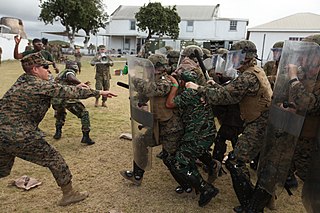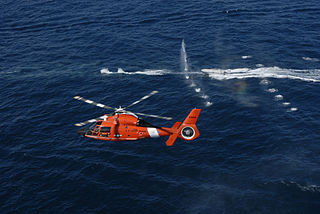Coercion involves compelling a party to act in an involuntary manner by the use of threats, including threats to use force against that party. It involves a set of forceful actions which violate the free will of an individual in order to induce a desired response. These actions may include extortion, blackmail, or even torture and sexual assault. For example, a bully may demand lunch money from a student where refusal results in the student getting beaten.

Non-lethal weapons, also called nonlethal weapons, less-lethal weapons, less-than-lethal weapons, non-deadly weapons, compliance weapons, or pain-inducing weapons are weapons intended to be less likely to kill a living target than conventional weapons such as knives and firearms with live ammunition. It is often understood that unintended or incidental casualties are risked wherever force is applied, but non-lethal weapons try to minimise the risk of casualties as much as possible. Non-lethal weapons are used in policing and combat situations to limit the escalation of conflict where employment of lethal force is prohibited or undesirable, where rules of engagement require minimum casualties, or where policy restricts the use of conventional force. These weapons occasionally cause serious injuries or death; the term "less-lethal" has been preferred by some organizations as it describes the risks of death more accurately than the term "non-lethal", which some have argued is a misnomer.

Handcuffs are restraint devices designed to secure an individual's wrists in proximity to each other. They comprise two parts, linked together by a chain, a hinge, or rigid bar. Each cuff has a rotating arm which engages with a ratchet that prevents it from being opened once closed around a person's wrist. Without the key, the handcuffs cannot be removed without specialist knowledge, and the handcuffed person cannot move their wrists more than a few centimetres or inches apart, making many tasks difficult or impossible.
A stun gun is a device used to immobilize an attacker without causing serious injury. Tasers, tranquillizer guns, and mace (spray) are all types of stun guns. Subcategories of stun gun include the electroshock weapon, an incapacitating weapon that momentarily disables either a beast or a person with an electric shock; and a directed-energy weapon that causes unconsciousness, a weapon that emits energy in an aimed direction without a projectile. Stun guns are frequently used by members of various armed forces and law enforcement agencies. The Multi-purpose stun gun was patented in 2014 in the United States by Hung-Yi Chang. The term is also used for various weapons in science fiction.

Electrical injury is a physiological reaction caused by electric current passing through the body. The injury depends on the density of the current, tissue resistance and duration of contact. Very small currents may be imperceptible or produce a light tingling sensation. A shock caused by low and otherwise harmless current could startle an individual and cause injury due to jerking away or falling. Stronger currents may cause some degree of discomfort or pain, while more intense currents may induce involuntary muscle contractions, preventing the person from breaking free of the source of electricity. Still larger currents result in tissue damage and may trigger ventricular fibrillation or cardiac arrest. Consequences of injury from electricity may include amputations, bone fractures and orthopedic and musculoskeletal injuries. If death results from an electric shock the cause of death is generally referred to as electrocution.

A Taser is a conducted energy device (CED) primarily used to incapacitate people, allowing them to be approached and handled in an unresisting and thus safe manner. Sold by Axon, formerly TASER International, the device fires two small barbed darts intended to puncture the skin and remain attached to the target, at 55 m/s. Their range extends from 4.5 m (15 ft) for non-Law Enforcement Tasers to 10.5 m (34 ft) for Law Enforcement Tasers. The darts are connected to the main unit by thin insulated copper wire and deliver a modulated electric current designed to disrupt voluntary control of muscles, causing "neuromuscular incapacitation." The effects of a taser may only be localized pain or strong involuntary long muscle contractions, based on the mode of use and connectivity of the darts.

A whip is a tool or weapon designed to strike humans or animals to exert control through pain compliance or fear of pain. They can also be used without inflicting pain, for audiovisual cues, such as in equestrianism. They are generally either a firm stick designed for direct contact, or a flexible line requiring a specialized swing. The former is easier and more precise, the latter offers longer reach and greater force. A hunting whip combines a firm stick with a flexible line.

Riot control measures are used by law enforcement, military, paramilitary or security forces to control, disperse, and arrest people who are involved in a riot, unlawful demonstration or unlawful protest.

An electroshock weapon is an incapacitating weapon. It delivers an electric shock aimed at temporarily disrupting muscle functions and/or inflicting pain without usually causing significant injury.
Medical torture describes the involvement of, or sometimes instigation by, medical personnel in acts of torture, either to judge what victims can endure, to apply treatments which will enhance torture, or as torturers in their own right. Medical torture overlaps with medical interrogation if it involves the use of professional medical expertise to facilitate interrogation or corporal punishment, in the conduct of torturous human experimentation or in providing professional medical sanction and approval for the torture of prisoners. Medical torture also covers torturous scientific experimentation upon unwilling human subjects.
Conflict escalation is the process by which conflicts grow in severity or scale over time. That may refer to conflicts between individuals or groups in interpersonal relationships, or it may refer to the escalation of hostilities in a political or military context. In systems theory, the process of conflict escalation is modeled by positive feedback.

In military and police contexts, a warning shot is an intentionally harmless artillery shot or gunshot with intent to enact direct compliance and order to a hostile perpetrator or enemy forces. It is recognized as signalling intended confrontations on land, sea, and air.
Nerve induction is a theoretical method of creating a sensation by stimulation of the sensory nerves rather than by actual stimulus.

A use of force continuum is a standard that provides law enforcement officers and civilians with guidelines as to how much force may be used against a resisting subject in a given situation. In some ways, it is similar to the U.S. military's escalation of force (EOF). The purpose of these models is to clarify, both for law enforcement officers and civilians, the complex subject of use of force. They are often central parts of law enforcement agencies' use of force policies. Various criminal justice agencies have developed different models of the continuum, and there is no universal or standard model. Generally, each different agency will have their own use of force policy. Some agencies may separate some of the hand-to-hand based use of force. For example, take-downs and pressure point techniques may be one step before actual strikes and kicks. Also, for some agencies the use of aerosol pepper spray and electronic control devices (TASER) may fall into the same category as take-downs, or the actual strikes.
There are documented and alleged cases of torture both inside and outside the United States by members of the government, the military, law enforcement agencies, intelligence agencies, health care services, and other public organizations.

Taser safety issues relate to the lethality of the Taser. The TASER device is a less-lethal, not non-lethal, weapon, since the possibility of serious injury or death exists whenever the weapon is deployed. It is a brand of conducted electroshock weapon sold by Axon, formerly TASER International. Axon has identified increased risk in repeated, extended, or continuous exposure to the weapon; the Police Executive Research Forum says that total exposure should not exceed 15 seconds.

A baton is a roughly cylindrical club made of wood, rubber, plastic, or metal. It is carried as a compliance tool and defensive weapon by law-enforcement officers, correctional staff, security guards and military personnel. The name baton comes from the French bâton (stick), derived from Old French Baston, from Latin bastum.
This article deals with the activities of the Central Intelligence Agency (CIA) of the federal government of the United States that are violations of human rights.
Compliance is a response—specifically, a submission—made in reaction to a request. The request may be explicit or implicit. The target may or may not recognize that they are being urged to act in a particular way.
A law enforcement agency (LEA) has powers, which other government subjects do not, to enable the LEA to undertake its responsibilities. These powers are generally in one of six forms:









